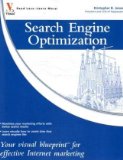 Reaching Your Target Audience Through Search Engine Optimization
Reaching Your Target Audience Through Search Engine Optimization
Once you have identified your target audience or demographic, you must streamline your online marketing strategy.
Understanding Search Engine Optimization (SEO) is vital. For a basic overview and useful tips, check out Search Engine Optimization: Your Visual Blueprint for Effective Internet Marketing by Kristopher B. Jones.
The illustrations of live screenshots make it easy to keep on track.
First, select appropriate search terminology
Use research and analysis tools (ie: Google Trends) for the most popular keyword searches.
Your key terms and phrases need to match your website content. That’s the easy part, now, here’s the tricky part. If your topic is highly competitive you may not be able to get top ranking on search engines.
[text_ad]
Think outside the box! Think of alternative key terms and phrases that visitors might search for online, like “publishing“ for “printing”. They might be slightly less searched for but will have far less competition, therefore, you will rank much higher.
Start with general terminology and progress to specific phrases.
Example:
Let’s use the key term “online publishing” – Google search returns over 1.5 billion results. Now, streamline the phrase to “online self publishing” – Google now returns 237 million results, 75% of your competition is eliminated. Next, type in “online self publishing “start a magazine”“ and Google returns only 15,900 results. Still seems like a large number but that’s very manageable in conjunction with other SEO techniques. Also, explore related topics such as “desktop publishing”, “ezines”, “online media” or “print on demand”, as long as they match your website content.
There are two kinds of keyword terms in this example, head and tail terms.
Head terms are short, usually one or two words, with high search volume.
Tail terms are longer phrases, three or four words, with lower search volume.
Balancing head and tail terms should generate large amounts of web traffic. Keep in mind, this process should be periodically reviewed and your key terms updated as more content is added to your website.
For more, read Search Engine Optimization: Your Visual Blueprint for Effective Internet Marketing by Kristopher B. Jones.
You can also read dozens of Search Engine Optimization articles right here.



I remember reading this years ago… it’s funny, I’m actually getting some nostalgia from a dang book about SEO. Lol.
I should read it again and see how much of it is still applicable nowadays.